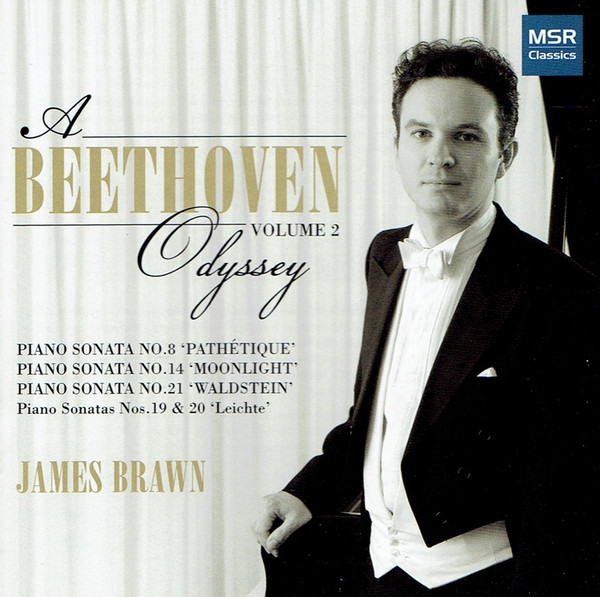Beethoven, Ludwig Van / A Beethoven Odyssey (Sonatas Nos. 30, 31, 32; James Brawn, Piano)
| Album: | A Beethoven Odyssey (Sonatas Nos. 30, 31, 32; James Brawn, Piano) | Collection: | Classical | |
| Artist: | Beethoven, Ludwig Van | Added: | Nov 2023 | |
| Label: | Msr Classics, | |||
A-File Activity
| Add Date: | 2023-12-10 | Pull Date: | 2024-02-11 | Charts: | Classical/Experimental |
|---|
| Week Ending: | Dec 24 |
|---|---|
| Airplays: | 1 |
Recent Airplay
| 1. | Dec 18, 2023: | Virtually Happy
Arietta (Adagio Molto Semplice E Cantabile (19:56), Sonata No. 32 in C Minor, Op. 111. Maestoso - Allegro Con Brio (9:27) |
||||
Album Review
Gary Lemco
Reviewed 2023-11-28
Reviewed 2023-11-28
The last of Beethoven’s 32 sonatas, E Major, Op.109; A-flat Major, Op. 110; and C Minor, Op. 111 composed 1820-1822, have retained their cult-like status, given B’s total deafness and their sheer, compressed intensity: Beethoven simultaneously created his Missa Solemnis, Diabelli Variations, and Ninth Symphony, leaving only the last 5 quartets to be competed to fulfill his ambitions.
B exhibits a sense of improvisation in his last sonatas, which also borrow heavily from Bach’s gift for counterpoint. The Sonata in E opens with a concentrated Vivace that emphasizes contrasts between tempos, inserting a rhapsodic Adagio espressivo. Its soft ending is immediately opposed by the 2nd mvmt, a violent Prestissimo. The last, expansive mvmt, Andante molto e cantabile, offers a theme and 6 variations. The theme proper is to be played “with inner-most feeling,” and the variants employ scale patterns and trills which release the bonds of form into the aerial realm of imagination.
The 1821 Sonata in A-flat bears a unique structure. The first mvmt indicates con amabilita, a guide to warmth of spirit. The main theme is derived from a German folk song, as is the theme for the final mvmt. The 2nd movement jars us with a fierce scherzo, Allegro molto. The last mvmt proves the most complex: it begins sadly, Arioso dolente, a song of lament. B then employs the fugue as a means of development, with a feeling of exhaustion and recovery, with a 2nd fugue to hint at the mysteries of creation. The song of thanksgiving evolves into a restored version of the opening phrase, now confident and triumphant.
The 1822 Sonata No. 32 in C Minor has 2 mvmts, a structure that has roots in Scarlatti’s music. The first mvmt, Maestoso – Allegro con brio ed appassionato, begins slowly and stormily, dark, forbidding music. The dramatic, fugal texture borrows from Handel. Only at the end does it modulate to a sunnier mode to prepare for the C Major of mvmt 2. Falling intervals mark the Arietta theme’s opening that generates the variations that follow. The complexity of development incudes the theme’s inversion, acceleration, pulverization into small units, and the use of the moving trill to embrace the keyboard’s full range, a gambit that Liszt and Scriabin later imitate. The Sonata ends in a haze of other worldliness.
B exhibits a sense of improvisation in his last sonatas, which also borrow heavily from Bach’s gift for counterpoint. The Sonata in E opens with a concentrated Vivace that emphasizes contrasts between tempos, inserting a rhapsodic Adagio espressivo. Its soft ending is immediately opposed by the 2nd mvmt, a violent Prestissimo. The last, expansive mvmt, Andante molto e cantabile, offers a theme and 6 variations. The theme proper is to be played “with inner-most feeling,” and the variants employ scale patterns and trills which release the bonds of form into the aerial realm of imagination.
The 1821 Sonata in A-flat bears a unique structure. The first mvmt indicates con amabilita, a guide to warmth of spirit. The main theme is derived from a German folk song, as is the theme for the final mvmt. The 2nd movement jars us with a fierce scherzo, Allegro molto. The last mvmt proves the most complex: it begins sadly, Arioso dolente, a song of lament. B then employs the fugue as a means of development, with a feeling of exhaustion and recovery, with a 2nd fugue to hint at the mysteries of creation. The song of thanksgiving evolves into a restored version of the opening phrase, now confident and triumphant.
The 1822 Sonata No. 32 in C Minor has 2 mvmts, a structure that has roots in Scarlatti’s music. The first mvmt, Maestoso – Allegro con brio ed appassionato, begins slowly and stormily, dark, forbidding music. The dramatic, fugal texture borrows from Handel. Only at the end does it modulate to a sunnier mode to prepare for the C Major of mvmt 2. Falling intervals mark the Arietta theme’s opening that generates the variations that follow. The complexity of development incudes the theme’s inversion, acceleration, pulverization into small units, and the use of the moving trill to embrace the keyboard’s full range, a gambit that Liszt and Scriabin later imitate. The Sonata ends in a haze of other worldliness.
Track Listing
